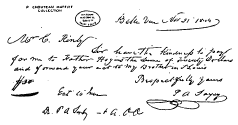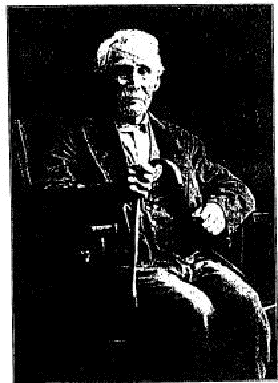|
life. - (From The Humboldt Leader. September 26.)
James Allison Walker died at his home in
Murray, September 20, aged eighty years. He came to Nebraska
from Pennsylvania in 1861, settling first at Rock Bluffs -
(From the Nehawka News, September 20.)
W. H. Banning, eighty-one years old, who
had lived near Union for the past sixty years, died
September 25. - (From the Morning World-Herald, September
26.)
Mary Ann Allen, of Overton. died September
19. She was born at Winterset, Iowa, October 9, 1864, and
moved to Nebraska with her parents in the year of her birth.
- (From the Ashland Gazette, September 26.)
Albert E. Rickley, son of John Rickley one
of the founders of Columbus, and who was born in that town
November 7, 1858, died at Hobart, Oklahoma, September 26. -
(From The Columbus Telegram, October 1.)
Peder Pedersen, born in Denmark, but a
resident of Omaha for the last fifty-four years, died
September 27. He drove ox teams hauling freight wagons
between Omaha and Virginia City, Montana, in 1864, and was
afterward a carriage builder in Omaha. - (From The Omaha
Daily Bee, September 28.)
Mrs. Frederica Kleihauer, born in Germany.
January 20, 1843, herself mother of twelve children, died at
her home in Auburn, September 17. She settled on a farm near
Johnson in 1865. - (From the Nemaha County Herald, September
20.)
Susan Catherine Wharton died at the home
of Mrs. Gilbert Blauser, near Diller, September 2. She was
born in Effingham county, Illinois, July 30, 1838; married
to Rev. L. B. Wharton, a Baptist preacher, near her home,
April 3, 1856; the family removed from Illinois to Cuming
county, Nebraska, in 1867, and again to Harbine, Jefferson
county, where they have lived ever since. Mr. Wharton died
December 14, 1897. - (From The Diller Record, September
6.)
Captain William Harrison Corbin of
Alliance died at Monticello, Illinois, September 11. He was
born in Mercer county, Pennsylvania, September 14, 1838;
served in the One hundredth Regiment, Pennsylvania
Volunteers, throughout life civil war, rising to the rank of
captain; returned to Monticello whence he came to Nebraska
in 1867; at first was employed by the Union Pacific Railroad
Company; afterward settled in Red Willow county, where he
was county judge and county clerk; removed in 1887 to Box
Butte county, where he conducted a ranch until 1900, when he
became vice president of the Alliance National Bank, holding
the office until his death. - (From The Alliance Semi-Weekly
Times, September 13.)
The military records show that Mr. Corbin
enlisted on August 27, 1861, as a sergeant in Company E. One
hundredth Regiment, Pennsylvania Volunteers; was discharged
December 28, 1863; reenlisted, and finally discharged March
14, 1865, with the rank of second lieutenant. This
organization was distinguished as the Roundhead
Regiment.
Elijah Sorter, born at Mayfield, Ohio,
November 7, 1845, died at his home, near Seward, September
2. At the age of seventeen he enlisted in the 150th
Regiment, Ohio Volunteers, and served throughout the war. At
its close he came west to Iowa; attended the state
university at Iowa City for a time; then came to Nebraska,
walking all the way; in 1870 took a homestead near Tamora;
was married to Miss Elizabeth Pickrel, July 3, 1875, and
seven children were born to them. He was a member of the G.
A. R. post at Seward. - (From the Seward
Independent-Democrat, September 12.)
Mrs. Sarah Nichol of Auburn died September
10, aged eighty-nine years. She was born in Scotland,
February 28, 1829; came to Illinois when she was sixteen
years of age; was married there in 1854 to William
Archibald; soon afterward the family came to Nebraska,
taking a homestead in Nemaha county; not long after her
husband died, and two years later she was married to Walter
Nichol, in Illinois, but they came to Nemaha county and
remained permanently. - (From the Nemaha County Herald.
September 13.)
Ben Johnston, aged sixty years, died at
his home at Steinauer, August 31. He was known all over
eastern Nebraska and Kansas as a trainer and driver of fast
horses. His father, who was born at Sterling, Nebraska,
November 23. 1857, was a pioneer preacher; the son lived at
a number of towns in Nebraska and Kansas before moving to
Steinauer. - (The Pawnee Chief, September 13.)
Christian Bull died at his home in Millard
on September 4, aged seventy-eight years. He came from
Mecklenburg, Germany, in 1865; settled first in Pennsylvania
and came to Nebraska two years later. He lived on his farm
near Millard from 1876 to 1900 and since 1900, in Millard. -
(From the Morning World-Herald, September 6.)
Mrs. Mary Ottens died September 4, at
Auburn, aged eighty
|
years. She was a native of Ireland: came to America at
the age of sixteen years; a year later, 1855, married in
Minnesota to Bernard J. Ottens; they came immediately to
Nebraska and settled on a homestead in what is now known as
the Hickory Grove neighborhood, in Nemaha county. - (From
the Nemaha County Herald, September 6.)
Eli Davis Shockey, born in Kentucky, May
25, 1824, died at his home in Hastings, August 7, aged
ninety-four years, two months and fourteen days. He came to
Richardson county, Nebraska, fifty-one years ago, where he
resided to the time of his death. - (From the Locomotive,
Lawrence, Nebr., September 6.)
James Hanlon, Sr., died September 2, at
Peru. He was born in Ohio, September 30, 1850; while he was
a child the family moved to Kentucky; on account of
political persecution near the beginning of the civil will,
they came to Nebraska, where they have lived ever since. Mr.
Hanlon was married to Miss Nettie Vance October 28, 1874. -
(From The Peru Pointer, September 6.)
George W. Richardson, born February 22,
1847, at Cleveland, Ohio; died August 24, near Oakland:
served in Company K, Third Regiment, Ohio Volunteers, during
nineteen months of the civil war; came to Omaha in 1867 and
for several years drove a stage between Blair and Omaha,
Calhoun and Omaha and Herman, Tekamah and Decatur. - (From
the Oakland Independent, August 30.)
Mrs. Elizabeth Reed Bell died August 26 at
Palmyra. She was born in England, February 9, 1827; married
to Thomas Bell, August 6, 1849; they came to Nebraska in
1867. Mrs. Bell was the mother of eleven children. - (From
Palmyra items in the Nebraska Daily Press, Nebraska City,
September 1.)
Mrs. Jeannette Graham, widow or Thomas
Graham, died at Omaha, August 29, aged eighty-one years. The
Grahams settled on a homestead in Seward county in 1857; but
Mrs. Graham moved to Omaha several years ago. - (From the
Blue Valley Blade. Seward, September 4.)
Some Recent Acquisitions of
the Society
The principal founders of St. Louis were an adventurous
group of Frenchmen whos principal business was trading with
the Indians of "the Nebraska Country", exchanging
merchandise or money for furs and peltries. The profits of
this trade were a very important factor in the growth of the
city for more than half a century. Thus St. Louis and
Nebraska mutually started each other. The names of these
traders were applied to many settlements, towns and other
geographical features in the valleys of the Missouri and the
Platte - though not as numerously, I think, as they ought to
have been.
Consequently St. Louis is the principal
depository of the early history of Nebraska, including
newspapers beginning in the year 1808, and biographical
sketches, business records and portraits of the pioneers
adverted to. I have laboriously examined the larger part of
these records, taking notes or copying data appertaining to
Nebraska and the outlying Northwest. In April, 1917, I
called on Mrs. Armand B. Peugnet at her home in St. Louis
for the main purpose of obtaining information about her
uncle, Peter A. Sarpy, who was the first permanent white
settler in Nebraska. Mrs. Peugnet, whose maiden name was
Virginia Sarpy, was born in St. Louis on July 4, 1827,
daughter of John Baptiste Sarpy and Adele Cabanne Sarpy and
niece of Peter A. Sarpy. She was anxious to learn from me,
in turn, all that I knew about her uncle's life in Nebraska
and presently called my attention to an oil portrait of him
hanging in an adjacent room. Impressed by the fact disclosed
in my information that his career here had been conspicuous
and important, she promptly agreed that the portrait ought
to be placed permanently with the Nebraska State Historical
Society. Mrs. Peugnet died on August 11, 1917, at the age of
ninety years and a month. In the following June, her
daughter, who was present when her mother promised that she
would leave the portrait to our Society, wrote me that it
would be sent as soon as a copy of it for the family could
be taken. Last July I again met Mrs. Berthold in St. Louis
and we made final arrangements for shipping the picture. It
is of somewhat more than life size, and it will be, perhaps.
the most valuable of the Society's collection of portraits.
A copy of it hangs in the gallery of the Missouri Historical
Society.
Last June Mrs. Berthold presented to the
Society photographic copies of portraits of Madame Peugnet;
John B. Sarpy, born to St. Louis, January 11, 1799;
Sylvestre Labadie, born in St. Louis in July, 1779, maternal
uncle of Peter A. and John B. Sarpy; Emilie Lauveur Labadie,
sister of Sylvestre, born in St. Louis in 1781, and married
in 1794 to Bernard Pratte, who was licensed in the
eighteen-
(Continued on Fourth
Page.)
|


